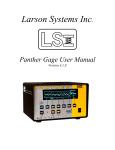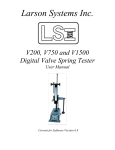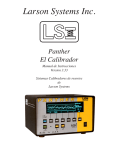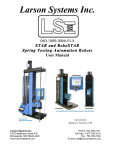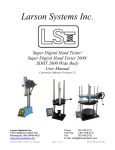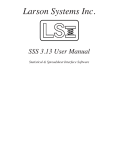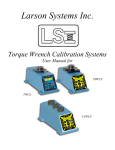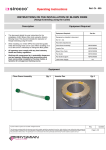Download Lynx User Manual (English)
Transcript
Larson Systems Inc. Lynx Gage User Manual Version 2.X Table of Contents OVERVIEW 1 FRONT PANEL OPERATION 2 FRONT PANEL CONTROLS ...............................................................................................................2 ROTARY CONTROL ........................................................................................................................2 FUNCTION MENU ...........................................................................................................................2 MULTIFUNCTION METER...............................................................................................................3 METER MODE INDICATOR .............................................................................................................3 TEST BUTTON AND READ LIGHT ..................................................................................................3 GAGE DISABLE ..............................................................................................................................3 ADJUSTER MOTOR ACTUATORS ...................................................................................................3 SORT INDICATOR ...........................................................................................................................3 GOOD SPRING COUNTER ...............................................................................................................3 OPERATING THE L Y NX GAGE 4 PROBE SETUP ....................................................................................................................................4 ZERO...............................................................................................................................................5 SORT POINT....................................................................................................................................5 DONE ..............................................................................................................................................6 NIST CALIBRATION ......................................................................................................................7 ADJUST POINT ...................................................................................................................................8 ADJUST TYPE ....................................................................................................................................8 AVERAGE .......................................................................................................................................8 EACH ..............................................................................................................................................9 ADJUST TIME ....................................................................................................................................9 SORT TIME ........................................................................................................................................9 SHUTDOWN ........................................................................................................................................9 CONSECUTIVE BAD .....................................................................................................................10 NO CUTOFF...................................................................................................................................10 CONSECUTIVE BAD .........................................................................................................................10 METER MODE .................................................................................................................................10 LAST SPRING................................................................................................................................11 AVERAGE (5)................................................................................................................................11 LAST 5 ..........................................................................................................................................11 SORT TIME ...................................................................................................................................11 ADJUST TIME ...............................................................................................................................11 CONSECUTIVE BAD .....................................................................................................................11 PROBE SETUP ...............................................................................................................................11 220VAC POWER INPUT OPTION 12 BACK PANEL CONNECTIONS 13 PROBE ..............................................................................................................................................13 READ ................................................................................................................................................13 SORT AND CONTROL OUTPUTS .....................................................................................................13 3 WAY SORT ....................................................................................................................................13 5 WAY SORT ....................................................................................................................................13 SHUTDOWN ......................................................................................................................................13 GOOD PULSE ...................................................................................................................................13 24 VDC OUTPUT INSTRUCTIONS ..................................................................................................14 LYNX ACCESSORIES .......................................................................................................................15 INSTALLING THE READ SWITCH ...................................................................................................17 INSTALLING A LENGTH ADJUSTER ...............................................................................................18 INSTALLING A SHUTDOWN CABLE ...............................................................................................20 INSTALLING A SORTING CHUTE....................................................................................................22 INSTALLING AN AIR SOLENOID FOR SORTING ............................................................................23 TO BLOW ON REJECT ONLY ........................................................................................................23 TO BLOW CONTINUOUSLY EXCEPT ON REJECT .........................................................................23 INSIDE THE LYNX............................................................................................................................24 REPLACING FUSES .......................................................................................................................24 REMOVING THE COVER ...............................................................................................................24 REPLACING THE BATTERY ..........................................................................................................25 REPLACING RELAYS ....................................................................................................................25 MOUNTING THE LYNX ON A CONTROL ARM .............................................................................26 LYNX SPECIFICATIONS ..................................................................................................................27 CONNECTOR PINOUTS....................................................................................................................28 Overview The Lion Precision LYNX Gage combines ease of use, a multifunction meter and display, and the proven reliability and accuracy of “Lion Gages” at a more economical price than state-of-the-art gages. Lion Precision is the original designer of non-contact spring length systems and we’ve been providing spring gages for over thirty years. The LYNX Gage continues a tradition of innovative, powerful and flexible systems for the spring manufacturing industry. The LYNX Gage System includes a computer-based control unit with a single rotary control for setting all gaging parameters. The multifunction meter shows current spring production quality in 3 different ways. The single rotary control system means an operator can quickly and easily operate the gage, even a first time user. Additional features of the LYNX Gage: • 3-Way and 5-Way sort capability • Monitor up to 30,000 springs per hour • Push-button zero and sort point set-up • Consecutive bad, and no cutoff shutdown modes • Good spring counter • Works with all older model accessory systems: chutes, pitch controllers, etc. !! The LYNX always gages !! Coiling and gaging can be done at full speed while performing any of the functions on the LYNX. The gage will not stop working when a new function is selected or values adjusted. Only probe setup will stop gaging. Of course you can disable gaging at any time. The LYNX Gage includes a drift free probe which is completely interchangeable with all other LYNX, PANTHER, and 300-9EX Gages: the probe does not need to be matched to a particular gage. The advanced design of the probe virtually eliminates drift from set-up points, a concern of older model gages. We hope you’ll find this instruction manual easy to read and understand. The engineers and support staff at Lion Precision have always believed it is important for our customers to understand and be comfortable with Lion Precision gages. That is why we try to avoid using jargon or obscure technical terms, and present information in a manner that is easy to understand. We figure the more our customers know about gaging, the better we look. And if something isn’t clear in the manual, we hope you’ll call us immediately. 1 Front Panel Operation The LYNX has only one control! The ROTARY control. It is used to select, activate, and set all the operations and values on the gage. Function Good Spring Menu Counter Multi Function Meter Meter Mode Indicator Rotary Control TEST Button & Read Light Disable Switch Adjust Motor Actuators Sort Indicator Power Switch Front Panel Controls Rotary Control This is the only control on the gage. It rotates to change values and selections, and it pushes like a switch to make selections and activate functions. This one control is used to operate all gage functions. Function Menu This stack of lights indicates which function is currently selected and whether or not it is active. If the light is blinking, the currently selected function is active. Active means the value of that function can now be changed by the rotary control. If the light is steady then pressing the rotary control will activate that function. 2 Multifunction Meter This meter can display 7 different things. It is used to indicate current production performance, sort time setting, adjust time setting, consecutive bad counts, and probe output voltage during probe setup. Meter Mode Indicator This stack of lights indicates what the meter is currently displaying. Test Button and Read Light Pressing this button will start a read cycle as if the read switch had been activated during coiling. This light is on as long as the read switch (or test button) is activated. If the magnet stops over the read switch the light will stay on. This makes it easier to set the position of the magnet and the read switch. Gage Disable When the red gage disable button is pressed, the gage will not respond to read switch or test button triggers. If the read switch is triggered the green light will still light but the gage will not measure, adjust, count, or sort. All other gage functions, the rotary control, and adjuster motor actuators will still function. The red light will be on as long as the gage is disabled. To re-enable the gage, press the red button again. Adjuster Motor Actuators Pressing either of these buttons will immediately cause the adjuster motor to turn. Each button turns the motor a different direction. The actual direction depends on the switch on the adjuster motor. These buttons will function at all times. They are never disabled. The lights indicate when the length adjust function is turning the motor. They remain on as long as the motor is in motion. Sort Indicator The lights of the sort indicator show sorting activity. The lights are activated for a bad part. The left light indicates a short part and the right light indicates a long part. If no lights are on then the part is good. Good Spring Counter The good spring counter is above the rotary control. This displays the number of good springs measured since the counter was last reset. The counter is reset to zero by pressing the black button on the bottom bezel of the counter. 3 Operating the LYNX Gage All operations on the LYNX gage are done by a three step process: 1. Turn the rotary control until the desired function is selected in the FUNCTION MENU. 2. Push the rotary control to activate the function. (The selected function light will begin to flash). 3. Turn the rotary control to make a selection or set the value. That’s all there is to it! When the LYNX is turned on, the version of the software is displayed by flashing lights on the multifunction meter. For instance, for version 1.3, the multifunction meter will flash the 1 light, then flash the 3 light. Probe Setup Overview The gage measures spring length by measuring percentage changes in the gap between the probe tip and the end of the spring. The gage must be calibrated for these changes to accurately represent changes in spring length. Calibration is done by setting a starting gap and zeroing the gage. This gap represents a perfect spring. Moving the probe tip to the gaps that represent the sort points and pressing the button teaches the gage what length springs to sort. It’s important that there is neither too little nor too much change in the gap when the sort points are set. The LED meter on the gage indicates the relative amount of change of the gap during the probe setup process. for proper setup, the meter must move at least. one LED from the center and it must not move all the way to the end of the scale. If the meter 4 does not move enough, move the probe tip closer to the spring, rezero and retry. If the meter moves too much, move the probe tip away from the spring, rezero and retry. As with any gage, probe setup consists of a few basic steps: 1. Wind a spring and stop it before it cuts off. 2. Adjust the probe to standoff from the spring .100” to .250”. 3. Zero the probe. 4. Adjust the probe micrometer and set the sort points. When the PROBE SETUP function is selected, the PROBE SETUP light will flash and the Zero light will light. The gage is now ready to zero the probe. The multifunction meter will be displaying the actual probe voltage; just like the meter on a traditional gage during probe setup. When probe setup is done, the adjust points are automatically set at _ of the sort points. These points can be changed at any time (see below). The probe setup can be checked using the meter mode setting of PROBE SETUP (see below). Zero When the probe tip is the desired distance from the spring, press the rotary control. Three things will happen: 1. The gage will zero the probe (the meter will move to the top center light). 2. The gage will beep twice. 3. The gage function will automatically move to PROBE SETUP - SORT POINT If the gage can’t zero the probe for some reason it will beep three sets of three rapid beeps. If this happens, check the following: • The probe is too close to the spring. • The tip is too big for the spring being made • The tip is bad. • The probe is bad. These are the usual things that prevent the gage from zeroing the probe. If the probe needs to be re-zeroed, use the rotary control to move the function indicator back to PROBE SETUP - ZERO and rezero the probe. The gage is now ready to set the sort points. Sort Point The sort points set the spring lengths that the gage will consider bad. If a sorter is connected, these springs will be sorted out. Set the sort points as follows: 1. Move the probe micrometer to either of the sort points. For example, if you want to sort at ± .005”, move the micrometer .005”. 5 2. Push the rotary control. The gage will beep twice and flash the light in the meter. 3. Then move the probe to the other sort point and press the rotary control again. The sort points must be at least one light away from the center and one light away from the end points. The gage will sound warning beeps if a sort point is attempted too close to zero, or too close to the end points on the meter (see overview above). Once sort points are succesfully set, the gage function will automatically go to DONE. Done Pressing the rotary control when PROBE SETUP - DONE is selected, will take the gage out of probe setup mode and return to normal operation. If you want to abort probe setup at any time, just use the rotary control to select DONE and press it; the gage will return to normal operating mode. 6 NIST Traceable Calibration Non-contact free-length measurements are completely dependent on the size, type, and shape of the spring being measured. For this reason the gaging system cannot be calibrated for absolute measurements. It must be calibrated for each individual setup. Calibrating according to these instructions will provide an accurate, NIST traceable calibration for each setup. Required Equipment: Mechanical gage calibrated to NIST (micrometer, caliper, etc.). Calibration process: 1. Wind a spring to cutoff. 2. Position the probe tip 0.050" to 0.250" (1mm to 10mm) from the spring end. 3. Zero the probe. Two beeps indicate successful zeroing. 4. Now move the probe to one of the sort points. On the Panther, be sure to move the probe the same amount as the tolerance listed at the top of the setup screen! 5. Set the sort point on the gage. Two beeps will sound to confirm the point is set. 6. Now move the probe to the other sort point. On the Panther, be sure to move the probe the same amount as the tolerance listed at the top of the setup screen! 7. Set the sort point on the gage. Two beeps will sound to confirm the point is set. 8. Press the DONE button. 9. Return micrometer to zero position before starting production. 10. Cutoff the setup spring. 11. Measure the free length of the setup spring with a NIST calibrated device. 12. If the free length is different than desired (different than nominal setting on Panther gage) then adjust the gage probe micrometer equal to the amount of deviation of the setup spring. If the spring is too short, move the probe micrometer away from the coiler. If the spring is too long, move the probe micrometer toward the coiler. 13. Start spring production. 14. Catch and measure a spring which the gage indicates is of nominal length (keep hands at least 4” away while catching springs). 15. If the free length measured with the NIST traceable device is different than the gage reading, readjust the probe micrometer. 16. Repeat steps 13 & 14 until NIST traceable device and gage reading are equal. This provides a NIST traceable calibration of the spring gage setup. 7 Adjust Point The adjust points set the spring lengths that will cause the gage to turn the adjust motor with the EACH adjustment type. If the AVERAGE adjustment type is selected, the adjust points have no effect. Set the adjust points as follows: 1. Select the ADJUST POINT function. The meter will now display the sort (tolerance) and adjust points. The tolerance is indicated by non-flashing lights at 25 and 5. The flashing lights show the current adjust points. Each light between center and the tolerance points equals 10% of tolerance. After probe setup, the adjust points are automatically set to 50% of tolerance, so the 5th lights are on after probe setup. 50% 80 Sort Points Each light equals 10% of tolerance, when setting the adjust points. 2. Turning the rotary control will move a light on the meter. Move this light to the new desired adjust point and push the rotary control. The gage will beep and set the adjust point. 3. Do the same for the other adjust point. 4. After the second adjust point is set, the meter will continue displaying the probe setup for two seconds, then return to the previous mode. To exit the ADJUST POINT mode without resetting the adjust points, move the select light to the center light and press the control. The gage will then return to its previous mode. Adjust Type The LYNX gage offers two different adjustment types. EACH and AVERAGE. Which is better will depend on the particular job being run. Generally speaking, AVERAGE should produce better results. When ADJUST TYPE is activated, turning the control knob will rotate through NONE, EACH, and AVERAGE. When the light is moved from one type to another, the gage changes adjust types immediately, it does not wait for the operator to push the control again. Average AVERAGE adjustment will make adjustments when the computer determines that the process is drifting off center. The computer makes this determination based on accumulated error. This value is similar to the average of the recent production. The amount the motor will turn is dependant on two things: 1. The ADJUST TIME setting - the higher the setting the longer it will turn 2. How rapidly the job is moving off center - the faster it is moving off center, the longer it will turn 8 30% Each EACH type adjustment will make adjustments when a spring length exceeds THE ADJUST POINT settings. The amount the motor will turn is based solely on the ADJUST TIME setting. Adjust Time Adjust time is related to the amount of time the adjuster motor turns when an adjustment is made. When this selection is activated the meter will display the adjust time setting. Turning the rotary control will change the adjust time. The change in adjust time is immediate. You do not have press the control again to make the change. In the EACH mode, the adjust time sets how long the motor will turn when a spring exceeds the adjust point. The range is from .02 seconds to about 1 second. In the AVERAGE mode, this amount is used as a starting point. The gage length adjust computer will adjust the time around the operator setting depending on the adjustment needed. Sort Time Sort time is the amount of time the sorting chute or air solenoid is held active when a bad spring is produced. When this selection is activated the meter will display the sort time setting. The sort time can be changed from a minimum of .1 seconds, to a maximum of 3 seconds. Turning the rotary control will change the sort time. The change in sort time is immediate. You do not have press the control again to make the change. Shutdown Because the gage will stop gaging during a shutdown, shutdown functions should only be used when the gage is wired to stop the coiler. When this function is activated, the rotary control will select different shutdown modes. The two shutdown modes can be selected individually or can operate simultaneously. A particular shutdown mode is enabled if the light next to it is lit. If neither light is on, no shutdown modes are enabled. When a shutdown occurs the gage will respond in the following ways: • Shutdown relay will be activated, stopping the coiler. • The gage will stop gaging springs. • The light next to the active shutdown will flash red. • The meter will oscillate. • The alarm will sound. The alarm will shut off after 30 seconds if the shutdown is not cleared. 9 To clear the shutdown and return to gaging, press the rotary control. !WARNING! When the shutdown is cleared the shutdown relay will immediately reclose. If the shutdown cable is not wired correctly through a contactor box the coiler could start unexpectedly. The two shutdown modes are as follows: Consecutive Bad CONSECUTIVE BAD shutdown will shutdown the coiler if a certain number of bad springs are produced consecutively. To set the number of consecutive bad springs on which to shutdown, select the CONSESUTIVE BAD function on the function menu. Then use the rotary control to set the number using the multifunction meter. Use the hash marks on the meter for reference. When CONSECUTIVE BAD is selected with the METER MODE function, the meter will display the current actual count of consecutive bad springs. This can be used to determine how many consecutive bad springs are typical for a job. No cutoff No cutoff shutdown will shutdown the coiler if a spring contacts the probe tip before it is cutoff. This shutdown will be immediate and can occur at any time, not just when the read switch has activated the gage. It is automatically disabled during probe setup and when the gage is disabled. Contact with the probe tip must be maintained for 0.25 seconds for shutdown to engage. A momentary contact as the spring falls will not shutdown the gage. Consecutive Bad When this function is activated, the rotary control can be used to set the number of consecutive bad springs at which the gage will shutdown the coiler. See shutdown section above for details on shutdown operation. Meter Mode When this function is activated, the rotary control will select the meter display mode. The multifunction meter has 7 different display modes. Three of the modes are used for operator feedback on production quality. The other modes are used for setting/displaying various gage values. 10 Last Spring In this mode, the meter will display the length of the last spring measured. This display mode gives immediate feedback on each spring as it is made; although it gives no indication of recent history. Sort Points Average (5) In this mode, the meter will display the average length of the last 5 springs measured. This display mode gives feedback on the average perfomance of the springs being produced. When displaying spring length, the 5 and 25 lights represent the sort points Last 5 In this mode, the meter will display the length of each of the last 5 springs measured. Up to 5 lights will be on simultaneously. This display mode gives immediate feedback on each spring, as well as a picture of the recent history. In this mode the operator can see the spread (range) and center of recent production. Sort Time In this mode, the meter displays current setting of the sort time. This mode is automatically selected when the SORT TIME function is selected from the function menu. Adjust Time In this mode, the meter displays current setting of the adjust time. This mode is automatically selected when the ADJUST TIME function is selected from the function menu. Consecutive Bad When this mode is selected with the METER MODE function it will display the current actual count of consecutive bad springs. When the consecutive bad value is being set by the CONSECUTINVE BAD function, it displays the consecutive bad shutdown setting. Probe Setup When this is selected by the Meter Mode function, the meter shows the current probe setup. Steady lights will show where the sort points are set. Flashing lights will show where the adjust points are set. During the PROBE SETUP function, this mode is automatically selected and displays the actual voltage from the probe. 11 220VAC Power Input Option The LYNX is available with a 220VAC Power Input Option. When this option is installed the power input to the gage is 220 VAC. There are no switches or jumpers to change. The 220VAC Power Input Option provides sort and control outputs of 24VAC @ 2 Amps maximum combined current as a standard. 24VDC output is available. With 24VAC output, the total power available to the sort and control outputs is 50 watts continuous or 75 watts with a 30% duty cycle. With 24VDC output the total power available to the sort and control outputs is 25 watts. ! W AR NI N G ! Operating sorting chutes or controller motors at the wrong voltage may damage the external device and/or the spring gage! 12 Back Panel Connections Probe The LYNX can be used with any Lion Precision spring gage probe. It is designed to take advantage of the PX595G Temperature Stable Probe. Connect the probe to this connector. Read Any standard Lion Precision magnetic read switch can be connected here. See Installing a Read Switch page 17 in the appendices for detailed instructions. Sort and Adjust Outputs These will connect to any Lion Precision sorting chute, air solenoid, or controller motor. If the Universal Power Input Option is installed the total power available at any one time is 50 watts continuous or 75 watts at a 30% duty cycle. Otherwise the outputs are 115 VAC and are fused at 2 amps. 3 Way sorting is the traditional method of sorting where the shorts and longs are separated to opposite sides and the good springs fall straight through the center. 5 Way sorting separates the reject longs and reject shorts the same way but divides the good springs into three equal divisions; long good, medium good, and short good. This functions as a presort for the grinding operation. To do 5 way sorting connect the LYNX to a five way sorting chute. Shutdown This connector is for a Lion Precision automatic shutdown cable (P/N B013-8250). It provides a set of normally closed relay contacts and a set of normally open relay contacts that switch when a shutdown condition occurs. See Installing a Shutdown Cable, page 20 for specific connection details. Good Pulse This connector provides a 300µS, NPN open-collector output pulse on every good spring. This pulse can used to control indexing tables containing parts bins or other external devices. The output can sink up to 150mA of current with a maximum DC voltage of 50VDC. This output is protected by a self resetting fuse in case of over current. It can be used to activate small relays or optoisolators for larger contactor systems. The output is on pin 8 and ground is on pin 5. 13 Good pulse output pins 24 VDC Output Instructions DC Output spring gages provide 24VDC outputs to activate adjusting motors and sorting devices. The total power output of the DC system is 24 Watts. Sorting system: Pin C of the sort connector is ground. Pin A outputs 24VDC relative to ground when an over sort is active. Pin B outputs 24VDC relative to ground when an under sort is active. Sorter connection: Sort Connector Pin No Over Sort Under Sort Sort A 0V 24V 0V B 0V 0V 24V Ground Ground Ground C B A UNDER Solenoid OVER Solenoid C Adjust/Control Connector Adjust/Control System: Pin C of the Adjust/Control connector is ground. Pins A and B output 24VDC between them during an adjustment. The direction of adjustment determines the polarity. Pin No Over Adjust Adjust Adjust Under A 0V 0V 24V B 0V 24V 0V Ground Ground Ground C A C A DC B B DC Motor Connection 14 Connector Pin Reference Lynx Accessories Description Lynx Gage - 120 VAC In / 120 VAC Out Lynx Gage - 240 VAC In / 24 VAC Out Lynx Gage - 240 VAC In / 24 VDC Out Temperature-Stable Heated Probe - PX595G (English) Temperature-Stable Heated Probe - PX595G (Metric) Micrometer for English Probe Micrometer for Metric Probe Digital Readout Micrometer Inch/Metric for Probe Extended Probe Tip Kit (1 Base & 5 Tips) Guarded Probe Tip - 5/8” DIA (16 mm) Guarded Probe Tip - 1” DIA (25 mm) Guarded Probe Tip - 1.5” DIA (38 mm) Guarded Probe Tip - 2.0” DIA (52 mm) PB309B - Fixed Probe Holder RP2 - Retractable Probe Holder RS-2E - Read Switch Assembly Magnet and Holder Assembly for RS-2E Magnet for RS-2E Read Switch - HS2E Proximity Sensor for RS-2E Magless - Read Switch Assembly Read Switch - Magless Proximity Sensor only Shutdown Cable Shutdown Bypass Connector AC335 Driver Assembly AC336 Gear Box, 20:1 AC336 Adapter 10-32, W100A 15 Part Number 025-0000-0641-00 025-0000-0641-01 025-0000-0641-02 025-0000-0658-02 025-0000-0658-03 013-5000-0162-00 013-5000-0163-00 3301-0020 025-0000-0655-00 025-0000-0597-03 025-0000-0597-00 025-0000-0597-01 025-0000-0597-02 025-0000-0640-00 025-0000-0573-00 025-0000-0648-00 025-0000-0613-00 013-5000-0165-00 025-0000-0650-00 025-0000-0648-01 025-0000-0572-00 025-1000-0426-00 025-0000-0652-00 025-0000-0589-00 025-0000-0590-00 018-0000-2548-00 AC336 Adapter 1/4-28, W10A AC336 Adapter 3/8-24, W11A AC336 Adapter Kit, 1/2-20, W115A AC336 Adapter Blank (up to 3/8” thread) AC336 Adapter Kit, Blank 1/4-Thru Hole (up to 1/2” thread) AC336 Flex Shaft, 8” AC337 Heavy Duty Driver Assembly AC337 Gear Box, 50:1 AC337 Adapter Kit, 3/8-24 AC337 Adapter Kit, 1/2-20 AC337 Adapter Kit, 5/8-18 AC337 Adapter Kit, 3/4-16 AC337 Adapter Kit, Blank 1/4-Thru Hole AC337 Flex Shaft 12” AC337 Anti-Rotation Bracket MC34-2 - 2 Way Air Powered Sorter, 120 VAC MC34-2 - 2 Way Air Powered Sorter, 24 VAC MC34-2 - 2 Way Air Powered Sorter, 24 VDC MC34 Flapper MC34 Funnel MC46-3 - 3 Way Air Powered Sorter, 120 VAC MC46-3 - 3 Way Air Powered Sorter, 24 VAC MC46-3 - 3 Way Air Powered Sorter, 24 VDC MC46-5 - 5 Way Air Powered Sorter, 120 VAC MC46-5 - 5 Way Air Powered Sorter, 24 VAC MC46-5 - 5 Way Air Powered Sorter, 24 VDC MC46 Flapper, Perforated MC46 Flapper, Solid MC46 Funnel Valve, 120 VAC Solenoid Valve, 24 VAC Solenoid Valve, 24 VDC (5.4w) Solenoid SC48-3 - 3 Way Electric Powered Sorter with Stand, 120 VAC SC48-5 - 6 Way Electric Powered Sorter with Stand, 120 VAC SC48 Solenoid SC48-3AP - 3 Way Air Powered Sorter with Stand, 120 VAC SC48-3AP - 3 Way Air Powered Sorter with Stand, 24 VAC SC48-3AP - 3 Way Air Powered Sorter with Stand, 24 VDC SC48-5AP - 5 Way Air Powered Sorter with Stand, 120 VAC SC48-5AP - 5 Way Air Powered Sorter with Stand, 24 VAC ASR1 - 2 Way Air Jet, 120 VAC ASR1 - 2 Way Air Jet, 24 VAC 16 018-0000-2549-00 018-0000-2550-00 018-0000-2515-01 018-0000-2551-00 018-0000-2515-00 013-5000-0151-00 025-0000-0596-00 025-0000-0595-00 025-0000-0593-01 025-0000-0593-03 025-0000-0593-02 025-0000-0593-00 025-0000-0593-04 013-5000-0155-00 018-0000-2578-00 025-0000-0566-00 025-0000-0566-02 025-0000-0566-01 018-0000-2560-00 018-0000-2497-00 025-0000-0538-00 025-0000-0538-02 025-0000-0538-01 025-0000-0537-00 025-0000-0537-02 025-0000-0537-01 018-0000-2498-00 018-0000-2499-00 018-0000-2502-00 019-0000-0146-00 019-0000-0148-00 019-0000-0149-00 025-0000-0576-00 025-0000-0578-00 025-0000-0574-00 025-0000-0582-00 025-0000-0582-02 025-0000-0582-01 025-0000-0580-00 025-0000-0580-02 025-0000-0600-00 025-0000-0601-00 Installing the Read Switch The Read Switch triggers the gage to measure the spring length, sort the spring, and adjust the pitch rod if necessary. The system consists of two basic parts: the read switch, and the magnet that triggers it. System accuracy can be effected by improper positioning of the read switch. Please confirm proper position before operating. Install as follows: 1. Install magnet assembly on the cam shaft of the coiler. Alternatively, it can be installed on any rotating part that turns once per cycle. 2. Mount the read switch so the magnet will pass within 0.1" of it every time around. 3. Position the magnet on the shaft so it triggers the read switch after the wire stops feeding and before the cutoff tool touches the spring. The read switch should be triggered as soon as possible after the wire feed stops. This allows maximum time for the reading to be taken before the cutoff tool touches the spring. Magnet Assembly Bracket Read Switch Rotating Shaft 17 Installing a Length Adjuster The following instructions describe the installation of a standard length adjuster. Actual components look slightly different. A length adjuster system consists of four basic parts: 1. Adjuster Motor 2. Flex Shaft; Connects the motor to the gear box 3. Gear Box; This provides a gear reduction for more precise adjustments 4. Threaded Adapter; Connects the gear box to the pitch rod. The adapter is selected to match the size and thread of the pitch rod on the coiler. See the Accessories list on page Error! Bookmark not defined. for a selection of adapters. Blank adapters are available for custom drilling and tapping. 18 Installation Sequence 1. Mount the appropriate threaded adapter (specified when ordered) to the Gear Box using the set screw. See figure below: 2. Thread the Gear Box onto the pitch rod with the label up. This position will prevent oil from leaking from the gear box. 3. The controller motor is mounted on the coiler such that the flex shaft is as straight as possible. Severe bends in the flex shaft will shorten the life of the flex shaft. 19 Installing a Shutdown Cable The LYNX provides automatic shutdown of the coiler under 2 different conditions: • Consecutive Bad Springs • No Cutoff To use the shutdown feature a contactor device must be installed on the coiler. The relay inside the LYNX is not capable of handling the coiler power lines directly! The gage provides one set of normally closed contacts and one set of normally open contacts. The normally closed contacts can be wired in series with the contactor deactivation circuit (stop switch). When a shutdown condition occurs the contacts will open, causing the contactor to remove power from the coiler. The normally open contacts can be used to activate an alarm or beacon if desired. The current rating for each set of contacts is 5A @ 125/250 VAC. Once the coiler has been wired for a shutdown cable, a normally closed set of contacts is required to run the coiler. The Lion Precision Shutdown Cable Bypass (P/N A014-6180) can be used to run the coiler without a gage. The shutdown cable contains four wires and has a connector that mates to the SHUTDOWN connector on the rear of the gage. The wiring diagram and schematic are shown below. The letters indicate the pins of the connector. The next page includes a schematic of a typical contactor box with shutdown installed. Normally Closed Contact A C Red White Green Black Normally Open Contact 20 B D A typical contactor circuit schematic with shutdown cable installed is as follows: 115 VAC In 3 Phase to Motor START CONTACTOR STOP 3 Phase In Red White Shutdown Cable Typical Installation Procedure: 1. Cut the wire in line with the stop switch. 2. Connect the one of the cut ends of the wire to the Red shutdown wire 3. Connect the other cut end to the White Shutdown Wire !!WARNING!! Confirm coiler and contactor manufacturers instructions before proceeding. Installing the Shutdown Cable should only be done by a qualified electrician. Improper installation can result in injury and or damage to the coiler and gage! 21 Installing a Sorting Chute A typical Sorting chute consists of three parts • The Main Body which includes the flappers and solenoids • The Stand Base • The Stand Shaft 1. Place base on floor and insert shaft. 2. Turn hex socket set screws in base to prevent shaft from moving. 3. Slide main body on top of shaft and tighten two hex head bolts. 4. Position the chute in front of the coiler. 5. Loosen hex socket set screws in the center of the shaft and raise chute body to catch springs. 6. Tighten set screws. 7. The chute should be as high as possible without interfering with the coiling process. This provides a shorter travel time for the springs after cutoff which assures more accurate sorting. 22 Installing an Air Solenoid for Sorting Lion Precision manufactures air solenoids for spring sorting. The ASR1-A which blows out all bad springs, short or long, in the same direction. This is the most common method of sorting by air. Air solenoids can be configured to blow only on reject or to blow continuously and stop only on reject. To Blow on Reject Only 1. Input air supply to inlet ‘1’. 2. Place plug in inlet ‘3’. 3. Position a line from outlet ‘2’ to blow out bad springs. 3 E 1 2 E PLUGGED To Blow Continuously Except on Reject 1. Input air supply to inlet ‘3’. 2. Place plug in inlet ‘1’. 3. Position a line from outlet ‘2’ to blow out good springs. E 3 1 2 ® PLUGGED The air solenoid can be mounted to blow right at the tooling or at another location where the spring will be passing as it falls after cutoff. Blowing right at the tooling usually provides a more reliable sort. It saves the operator from creating a “spring guide” of cardboard to direct the spring in front of the solenoid. Caution must be used when blowing at the tooling. If the air continues to blow into the coiling process some springs can be deformed. Blowing on the spring when the gage is reading the length can give an inaccurate reading if the spring end is pushed away from the probe tip. These considerations depend on the air pressure in the solenoids and wire type of the job. 23 Inside the LYNX Should the gage ever require service, much can be done in the field by the operator or maintenance department. Such as: • Replacing sorter and motor drive relays • Replacing shutdown relay • Replacing the battery Replacing Fuses Two 2A, 250V, 5x20mm fuses are located in the IEC connector where the power cord plugs into the gage. A small screwdriver may be required to remove the fuse block. Removing the Cover To remove the cover: 1. Unscrew and remove the four feet. 2. Remove the five screws on the bottom of the gage. 3. Slide the cover toward the rear of the gage. 4. When the handle makes contact with the rear panel, tilt the rear of the cover up and pull the cover off at an angle. 5. To reinstall, reverse the procedure. 24 Replacing the Battery The battery maintains the good spring counter, gage settings, and probe setup when power is off. Should any of these functions fail the battery probably needs replacement. A new battery can last up to 10 years. The battery can be ordered directly from Lion Precision or from a local distributor. The battery is as follows: Type: Lithium Voltage: 3V Size: 2/3A Placing the battery in backwards can damage the gage!! Follow the diagram next to the battery holder!! Replacing the H-Bridge and Relays Should the motor or sorter stop operating or begin to operate continuously, the most likely cause is a bad relay. The map below shows the location of the relays responsible for different functions. Shutdown Relay - 007-4000-0021-00 AC Solid State Relay (Black) - 007-4000-0018-00 DC Solid State Relay (Red) - 007-4000-0024-00 H-Bridge - 025-0000-0547-00 25 Mounting the LYNX on a Control Arm Three holes are provided on the bottom of the LYNX chassis to provide mounting to an instrument mounting arm. The holes are threaded 1/4 20. Maximum penetration into the gage chassis is 1/2". 7.32 (185.9) Front 3.73 (94.7) 0.00 (0.00) Bottom View inches (mm) 7.03 (178.6) 3.90 (99.1) 0.00 (0.00) 1.20 (30.5) 26 LYNX Specifications Power In Standard With 220VAC Power Option Sort & Control Power Output (Output voltage for Sort and Control must be the same) 115 VAC 50/60HZ @ 250 Watts 220 VAC 50/60HZ @ 250 Watts 115VAC Output (Standard on 115VAC Input models) 115VAC 1.5A Continuous 24VAC Output Option (Standard on 220VAC Input models) 24VAC 2.0A Total Continuous 24VAC 3.0A Total 30% Duty Cycle Max 24VDC Output Option 24VDC 1.1A Total Continuous Shutdown Relay Contacts Maximum Gaging Rate Sort Active Time Control Active Time 125/250VAC 5A 30,000/hour 0.1 - 3.0 Seconds ~ .02 - 1.0 Seconds 27 Connector Pinouts Probe 3 Way Sort 5Way Sort A B C D Probe Drive (1 MHz) Probe Return +15VDC Ground Control A B C A B C D E F Over Under Common Over Under Under Good Over Good No Connection Common Shutdown Read 28 A B C A B A B C D Over Under Common Read Signal +15VDC Norm Closed Contact 1 Norm Closed Contact 2 Norm Open Contact 1 Norm Open contact 2 Gaging System TWO YEAR WARRANTY The Larson Systems Inc. Gaging System parts and labor are warranted against defects in material and workmanship to the consumer for a period of twenty four months from the date of purchase. The foregoing warranty is exclusive and in lieu of all other warranties whether written, oral, or implied (including any warranty of fitness for purpose). This warranty covers all parts, except consumable items. It applies only to gages and accessories which have been installed and operated in accordance with instructions in our reference manuals, have not been tampered with in any way, misused, suffered damage through accident, neglect or conditions beyond our control and have been serviced only by authorized personnel. Larson Systems Incorporated is not responsible for loss in operating performance due to environmental conditions, such as humidity, dust, corrosive chemicals, deposition of oil or other foreign matter, spillage or other conditions beyond our control. There are no other warranties expressed or implied, and Larson Systems Incorporated shall not be liable under any circumstances for incidental or consequential damage. If it appears within two years from the date of shipment by Larson Systems Inc. that the equipment as delivered does not meet the warranties specified above and the Purchaser so notifies the Larson Systems Inc. promptly, Larson Systems Inc. at its Mpls MN facility, shall correct any defect, including non-conformance with the specifications, at it’s option, either by repairing any defective part(s), or by making available a replacement or required part. Warranty service is conducted at LSI’s facilities in Minneapolis, MN. Return the tester freight prepaid during the warranty period, and Larson Systems Incorporated will make a warranty determination, repair and return the tester freight collect. Shipments sent collect will be rejected. The foregoing shall constitute the sole remedy of the Purchaser and the sole liability of Larson Systems Inc. 29 Larson Systems Inc. 10073 Baltimore Street NE Minneapolis, MN 55449-4425 www.larsonsystems.com 30 763-780-2131 1-877-780-2131 Fax: 763-780-2182 [email protected] 060-1000-0052-00A

































